Part II
Internet tools
If you have ever used Google
(www.google.com)
to search the internet, then you have relied upon Free Software.
That is because Google's website runs on tens of
thousands of computers and each of these is using the GNU/Linux
operating system and the Apache web server.
Google's scientists have stated many times that
only Apache and GNU/Linux can provide the stability and security
required to serve the millions of web users every day. And only with
Apache and GNU/Linux could they have afforded to buy so many scores
of thousands of computers.
That is why Google, Amazon, Yahoo!, eBay and
numerous other companies depend on Free Software. In fact, almost 70%
of websites are run using the Apache web server Free Software and the
computers of many websites use Free operating systems like GNU/Linux
or BSD Unix.
Your organisation does not need to have as many
customers as Google does to be able to benefit from Free Software's
internet tools. The fact is that the free cost of Free Software means
that everyone can afford to use it. And as this part of the book will
show you, the Free tools available are often superior in quality to
commercial software.
Browsing the web
with Firefox
“I suggest dumping Microsoft's Internet
Explorer, which has a history of security breaches. I recommend
instead using Mozilla Firefox. It’s not only more secure but
also more modern and advanced, with tabbed browsing and a better
pop-up ad blocker.” — Walt Mossberg, Wall Street
Journal, September 16th 2004.
In the preface I mentioned that one of the
advantages of Free Software is that it breaks monopolies and that
that is a good thing. Web browser software is a great illustration of
this point.
The world wide web was literally invented by Tim
Berners-Lee, a British physicist working at CERN, the world's largest
particle physics laboratory. Sir Tim, who received a knighthood in
2004 for his efforts, created a standard for web pages and designed
software for looking at those pages. The standard that he created was
brilliant because it made writing web pages so easy. His software was
not so brilliant, but Sir Tim made sure that anyone else could write
software for browsing and creating pages. In fact, he deliberately
refused to make money from his world wide web so that other
developers would be free to create better and better software tools.
This worked magnificently and one of the first
companies to take advantage of the web was Netscape. Their browser
software was powerful and free of charge for non-commercial users. In
the mid-1990s, up to 90% of people reading web pages were doing so
with Netscape's web browser.
In 1995, Microsoft launched its own web browser,
Internet Explorer,
which was initially inferior to Netscape's. However, Microsoft could
afford to give the software away free of charge because it was making
so much money from Windows and Office software. Furthermore, it
included Internet Explorer with Windows and made it the default
browser. Today around 90% of web users do so with Internet Explorer.
This does not mean Internet Explorer is the best
browser. In the last few years features like tabbed browsing and
integrated customised searching and themes have dramatically improved
the experience of browsing the web. However, Microsoft has not added
any of these to Internet Explorer.
Furthermore, Internet Explorer has been downright
dangerous, exposing computers to attacks. These dangers drove the
governments of the USA
and Germany,
as well as several security companies, to advise against using
Internet Explorer.
There are several reasons for this state of
affairs. First, the incentives: Microsoft does not make any money
from you when you use its web browsing software, its only interest
being to to ensure that other web browser companies pose no threat to
its monopoly. Because they have achieved this, obtaining 90% market
share, they have no further incentive to improve the software.
Companies like Opera
(www.opera.com)
sell web browser software, so they are constantly adding features
because they must constantly fight for income.
Second, many of the security risks risks come from
a similar problem of incentives. At the time that Microsoft was
trying to beat Netscape, they added features like ActiveX to Internet
Explorer that allowed them to advertise capabilities that Netscape
could not match. Netscape could not match these because the features
depended on having direct access to the Windows code. But ActiveX had
significant security risks.
Microsoft advertised the features despite the risks.
The advertising is gone, because Netscape's threat
is gone, but on millions of PCs today the security risks remain.
Finally, Microsoft simply cannot do everything
right because no one can be so perfect. It only has so many software
developers, they can only spend so much time analysing their code for
security risks and they only have so much expertise about security.
This chapter is about Mozilla
Foundation's approach to web browsers and its product, Firefox
(www.mozilla.org/firefox).
The Foundation funds developers who are passionate about web browsing
software. The tools are further checked by people from all over the
world who are also passionate about browsing software. All these
people use Firefox. If there is a problem with the software they know
about it soon and they fix it soon after. They depend on the software
being of high quality, which is why they have an incentive to fix it.
Second, the developers were concerned about
security from the start. They lay the foundations for good security
in their software because the it will be used by important people in
mission-critical projects.
Furthermore, the code that they produce is
available for everyone to see. The paradox of security is that by
exposing every security hole it is easier to ensure security –
experts around the world are constantly scrutinising Firefox code and
pointing out deficiencies. On the other hand this should not surprise
us.
The democracies of the West flourished while the
Communist states of the Soviet Union collapsed because
the democracies shared information with their citizens, not despite
it. Transparency encourages security.
Finally, by making the
code available to everyone, it is much easier to build good
extensions to the code. The rest of this chapter will show you these
tools and end with technical explanations of how to get them and use
them.
But the main point for
now is that the monopoly is breaking and that is good for users of
the web. Every week brings more articles praising the superior
quality of Firefox versus Internet Explorer. Every week more computer
users decide that using the web is faster, more powerful and simply
more pleasant when using Firefox. And every week decision makers in
governments, companies and organisations make the decision that the
security of their computer network depends on using Mozilla's
software.
Microsoft will simply
have to respond by improving the quality and security of Internet
Explorer. All computer users will be winners from such improvements.
Until that day, you can benefit by switching to Firefox.
Examples
Ms
Yates searches Google, uses tabs and avoids pop-up windows
(page 6)
Mr
Salah Al-Din searches for meaning (page
7)
Dr
Digitalis searches PubMed (page 8)
M.
Braille downloads entire websites (page
10)
Mr
Big's team improves security, creates bookmarks and designs a theme
(page 11)
Ms Yates searches
Google, uses tabs and avoids pop-up windows
 Firefox
makes searching easy. Rather than visiting Google to begin a search,
type your search text into text area in the top right corner of
Firefox (see Figure 1) and press the return key. Firefox will show
you the list of results from Google. The tabs feature allows you to
study these results quickly.
Firefox
makes searching easy. Rather than visiting Google to begin a search,
type your search text into text area in the top right corner of
Firefox (see Figure 1) and press the return key. Firefox will show
you the list of results from Google. The tabs feature allows you to
study these results quickly.

Ms Yates typed “handheld computer
accessories” into the search bar. She decided that the first
ten companies in the list would be the the most important source of
competition or partnerships.
With the right mouse button,
she clicked on the title of the first website, then with the left
mouse button she clicked on Open
Link in New Tab. At the top of
Firefox, a tab appeared with the title of that website. She repeated
this for the next nine websites and nine new tabs appeared for the
websites (see Figure 2).

By clicking on the title of each tab, she could
see each company's website. Comparing different companies' sites by
clicking on the different tabs was easy and quick.
Firefox was a particularly good time saver when Ms
Yates connected to the internet through her laptop's dial-up modem.
She frequently had to do this while travelling, which meant that she
was often in a hurry, but that she had a slow internet connection. By
opening multiple tabs for browsing, she found that by the time she
had finished reading the text of the web page of the first tab, the
text of all the other tabs' web pages had finished loading.
This is because Firefox works efficiently on
multiple tasks, like loading other tabs, even as it remains
responsive to your main task, which is reading a particular web page.
It also avoids wasting time by blocking the windows that pop up on
some sites, often called pop-up windows. These are almost always
advertisements and Ms Yates was delighted that she was no longer
bothered by them.
Mr Salah Al-Din
searches for meaning
 Google
is not the only search engine that Firefox offers. Click on the
Google
is not the only search engine that Firefox offers. Click on the
 icon to see a list of alternatives included with Firefox and click on
Add
Engines... to see a huge and
expanding list of other search engines you can add.
icon to see a list of alternatives included with Firefox and click on
Add
Engines... to see a huge and
expanding list of other search engines you can add.
Mr Salah Al-Din was delighted
to find the Wikipedia (www.wikipedia.org).
It meant that he could search this encyclopaedia from the top
right-hand corner of Firefox. There were all sorts of other
encyclopaedias for him to choose from, including HowStuffWorks
(www.howstuffworks.com)
and Microsoft Encarta (http://encarta.msn.com/).
He
also found a list of dictionaries, from which he chose the Wiktionary
(www.wiktionary.org).
Others on the list included the Cambridge Dictionary
(http://dictionary.cambridge.org)
and the Merriam-Webster Thesaurus (www.merriam-webster.com).
He made sure that all of the students' PCs had the encyclopaedia and
dictionary searches added.
Dr Digitalis
searches PubMed
 PubMed
(www.pubmed.gov)
provides the abstracts of the papers from most modern biomedical
journals. It is run by the US government's National Center for
Biotechnology Information (NCBI).
PubMed
(www.pubmed.gov)
provides the abstracts of the papers from most modern biomedical
journals. It is run by the US government's National Center for
Biotechnology Information (NCBI).
Dr Digitalis had found it an invaluable resource
when dealing with unusual clinical problems because she could find
the very latest papers that could help answer her questions.
Using the Add
Engines... feature she added NCBI
PubMed to her search engines,
speeding up her PubMed searches.
She also found PubMed
Central
and PubMed
Books
as search engines for other NCBI tools. The first allowed searching
papers for which the entire text was available. This was very useful
because her private practice had not yet subscribed to many journals,
which had previously meant that Dr Digitalis could read only the
abstracts for free and would have to request the full copies from her
local medical library. Searching PubMed Central meant that any papers
that did appear would instantly be available free of charge.
PubMed Central makes all these
papers available because the journals that published them did so
under an Open Access licence (www.doaj.org).
This is the publishing world's equivalent to Free
Software, because it means that there are no restrictions on the
viewing and redistribution of the digital version of the papers. In
2004 the US Congress passed legislation so that papers from any
research that received Federal funds would be made available through
PubMed Central in this way. The UK's Parliament is also looking at
similar legislation for British science, as are the governments of
Germany, France and Japan.
Dr Digitalis found that the NCBI Bookshelf
(“PubMed Books”) also provided an incredible amount of
free biomedical information, but in the form of textbooks. For
example, the HSTAT series of textbooks
provided US government guidelines on the treatment of a wide range of
diseases.
She frequently used the PubMed
Books search engine to look up
biological terms with which she was not familiar. This led her to
textbooks like Stryer's Biochemistry
and Baron & Samuel's Medical Microbiology
because they covered areas of medical science that were not her
strongest. To her surprise, the books were well-written and actually
enjoyable to read, a refreshingly different experience from her early
years at medical school.
M. Braille
downloads entire websites
 Like
Mr Salah Al-Din, M. Braille added the Wikipedia search engine to the
top right corner of Firefox, but he used the French version of the
encyclopaedia (http://fr.wikipedia.org).
Like
Mr Salah Al-Din, M. Braille added the Wikipedia search engine to the
top right corner of Firefox, but he used the French version of the
encyclopaedia (http://fr.wikipedia.org).
However, his students could not use the
encyclopaedia, nor even the web in general, because the school did
not have internet access.
M. Braille could use the
internet in his home through his own PC and phone line. When he found
a page that would be useful for his lessons, he selected Save
Page As... from the File
menu and Firefox would save a copy of the page on his floppy disk. M.
Braille would then take the disk to school and copy the page from the
disk to every computer.
He was careful to only do this from sites that
gave permission. He found many sites, like the Wikipedia, which used
the GNU Free Documentation License, which gave him all the freedom he
needed to make copies in this way.
But soon he found that he wanted several related
pages from each site and the process of saving each individual page
was lengthy and burdensome.
Spiderzilla
(http://spiderzilla.mozdev.org)
is an Extension
that solves this problem. By clicking Download
this site from the Tools
menu, M. Braille could download entire websites onto his computer. He
could then copy these onto the computers at the school and the
children could browse around the sites without needing internet
access.
Mr Big's team
improves security, creates bookmarks and designs a theme
 Mr
Big's Chief Technology Officer was relieved when the IT department
installed Firefox on all the PCs in all the hotels. Using Firefox
rather than Internet Explorer removed several important security
threats. It also saved the time of IT department staff who were
having to constantly keep up with Microsoft's security patches for
Internet Explorer and ensure that all of them were installed on all
PCs.
Mr
Big's Chief Technology Officer was relieved when the IT department
installed Firefox on all the PCs in all the hotels. Using Firefox
rather than Internet Explorer removed several important security
threats. It also saved the time of IT department staff who were
having to constantly keep up with Microsoft's security patches for
Internet Explorer and ensure that all of them were installed on all
PCs.
With this security risk removed, the CTO felt more
confident about his plan to provide computers for customers in all of
the hotel lobbies. He wanted customers to be able to use the machines
to get information about their hotel and about the local area.
To achieve this, the IT staff
changed the default starting web page for Firefox in each hotel. They
selected Options...
from the Tools
menu and clicked on General.
Under Home
Page, they typed in the web address
for the hotel chain's website, then clicked the OK
button.
This meant that when a customer began browsing the
web on a PC in the hotel lobby, the first web page to appear would be
the hotel's. If the customer wanted to get back to that page, they
could just click the
 icon.
icon.
The IT staff also taught the
hotel staff how to add bookmarks that would be useful to customers
wanting to learn about the local area. For example, the Washington
Post's local events page is useful for hotels in the Washington,
DC area. The easiest way was to visit the right web page, then click
Bookmark
This Page... (see Figure 3). The
customer could visit that web page again by clicking on the Bookmarks
menu and then on the web page's name.
The Themes
feature in Firefox allows changing the colours and icons of the web
browser. Selecting Get
More Themes shows a list of freely
available themes. Creating a theme takes a little more work, but the
MozillaZine website provides clear explanations and examples.
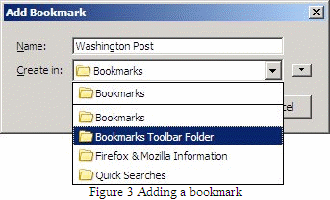
Naturally, the marketing department wanted to use
this for branding. Soon the hotel had its own Firefox theme and it
was installed on all the machines in the lobby.
Further
resources
Using email with
Thunderbird
According to Grant Thornton's 2005 International
Business Owners Survey the average US business owner spends two hours
every day using email. Nor is this the highest average –
business owners in the Philippines reported spending 2.1 hours per
day. They were also highly optimistic about the internet, 84% of them
reporting that the internet had increased their revenues. The French
view was more sceptical, only 13% responding so positively about the
internet. However, they still spent close to one hour per day using
email.
Whether you are of the French or the Filipino
school of thought, it is clear that the internet has an important
role to play in our institutions and many of us spend a significant
part of each day reading and writing emails. Given this popularity it
is no surprise that spammers have targeted email as a way to reach
millions of people cheaply.
What is surprising is how long so many people
tolerate using email software that is vulnerable to viruses.
Microsoft's Outlook and Outlook Express are by far the most popular
software tools for email, but they have also been the reason for the
spread of the most devastating viruses. Sasser, Blaster, Nachi and
Sobig were notorious names in the last two years, affecting literally
millions of machines around the world.
Of course part of the reason for their creation is
that malicious creators of computer viruses target the most popular
software to cause the most damage. But the other component is that
Microsoft had made some uniquely bad security decisions
in the past and the users of Outlook and Outlook Express have
suffered because of this.
Email does not
have to be this way – and Mozilla's Free Software gives you
impressive alternatives (www.mozilla.org/thunderbird).
Examples
Dr Digitalis switches to
Thunderbird and imports her old email messages
(page 16)
Mr Salah Al-Din switches
from POP to IMAP for accessing his email at home
(page 18)
Mrs Shrub reads the news
with RSS (page 19)
M. Braille filters out his
spam mail (page 21)
Ms Yates uses extensions
(page 23)
Mr Big uses Mozilla suite
(page 24)
Dr Digitalis
switches to Thunderbird and imports her old email messages
 The
Thunderbird installer automatically asks you if you want to import
your old email messages and settings. It can import data from
Outlook, Outlook Express and Eudora, as well as other email software
from Mozilla.
The
Thunderbird installer automatically asks you if you want to import
your old email messages and settings. It can import data from
Outlook, Outlook Express and Eudora, as well as other email software
from Mozilla.
This was a great relief to Dr Digitalis as she was
worried about her old messages. Because she had so many old emails,
the process took about half an hour.
After this, however, Thunderbird was quite fast.
In fact Thunderbird indexes all email messages in advance so that
searching through them is much faster than with Outlook or Outlook
Express. You can quickly find an email by a particular person, or
with a particular phrase in the subject, by typing next to the
 icon.
icon.
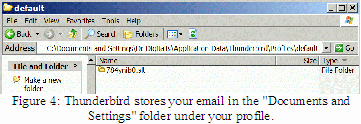
Finally,
Dr Digitalis was relieved at how easy it is to back up messages. As Figure 4
shows the Dr
Digitalis folder is insider her
computer's Documents
and Settings folder. This contains
the Application
Data folder, which contains the
Thunderbird
folder, which in turn contains all her emails. Making a backup copy
of this folder meant that all her messages were backed up.
This method is
good for several reasons. First, the folder itself is easy to find –
Outlook Express and Outlook use cryptic names for their storage.
Second, Outlook stores the messages for each user in just one file.
If any message in that file is corrupted, the whole of the file –
and all the messages it contains – can no longer be opened.
Because Thunderbird creates a folder on your computer for each
message folder that you create in Thunderbird from the File
menu.
Third, backing up a folder to a CD can be easier.
If the size of a file exceeds that of your backup medium (around 700
MB for a CD) splitting up that file is complicated. Because
Thunderbird uses a folder that contains several smaller files and
folders, it is more likely that each of these files will fit inside
your backup medium.
Mr Salah Al-Din
switches from POP to IMAP for accessing his email at home
 Thunderbird
can connect to POP and IMAP email servers. POP stands for Post Office
Protocol and is a common method for managing email within an
organisation. Commercial email accounts from companies like Yahoo!
and Google also provide POP servers for their customers.
Thunderbird
can connect to POP and IMAP email servers. POP stands for Post Office
Protocol and is a common method for managing email within an
organisation. Commercial email accounts from companies like Yahoo!
and Google also provide POP servers for their customers.
Mr Salah Al-Din had a computer at home that he
used to check his email outside of school hours. Initially, he had
set up Thunderbird so that it connects to the school's POP electronic
mail server.
However, the
default for Thunderbird and most email software is to remove email
from a POP server. In other words every time Mr Salah Al-Din clicked
the Get
Mail button, Thunderbird downloaded
messages from his POP server to his computer then deleted the
messages on the POP server. This is useful for saving space on the
POP server.
However, for Mr Salah Al-Din this was a major
inconvenience – as soon as he checked his email on his home PC
it would not be available the next day on his work PC. And at home he
could not access any of the messages that had been downloaded to his
PC at work earlier during the day.
Initially the
solution was to switch off the deletion using the Account
Settings item from the Tools
menu.
However, an even
better solution was possible when the school switched to using IMAP
(Internet Message Access Protocol) rather than POP for running the
email server. First, almost as soon as an email arrived for Mr Salah
Al-Din on the school's email server, it appeared on the PC he was
using. He no longer needed to click the Get
Mail button.
Second, the message was not deleted from the
server when it appeared on his computer – rather, Thunderbird
gave Mr Salah Al-Din direct access to what was on the server. This
meant that the messages that Mr Salah Al-Din read in the evening on
his home PC were available for him to see the next day on his work
PC.
In addition, the Thunderbird interface on both
machines indicated which messages he had already read, because their
titles were not in bold text (see Figure 5). The
 icon showed which messages he had replied to the night before.
icon showed which messages he had replied to the night before.

In fact, Thunderbird keeps a copy of the messages
sent on the IMAP server, so no matter which computer Mr Salah Al-Din
used for sending and receiving his messages he would always be able
to see all of these messages.
Finally, he installed
Thunderbird onto his laptop. The Account
Settings dialogue included an option
to keep an offline copy of the mail from the IMAP server. This
allowed Mr Salah Al-Din to see his old email messages even while not
connected to the internet.
Mrs Shrub reads
the news with RSS
 Thunderbird
offers a useful way of getting the news. This is because many
websites offer RSS versions of their news stories and Thunderbird can
use RSS to collect those stories. RSS stands for the Really Simple
Syndication, but the name belies the power that it offers and the
professionalism of the organisations that offer it.
Thunderbird
offers a useful way of getting the news. This is because many
websites offer RSS versions of their news stories and Thunderbird can
use RSS to collect those stories. RSS stands for the Really Simple
Syndication, but the name belies the power that it offers and the
professionalism of the organisations that offer it.
Mrs Shrub liked to start her day by reading the
newspapers while watching the BBC's news on TV. She was intrigued to
learn that the BBC offers RSS feeds from its news site
(see Figure 6).
To use RSS, look out for the
 icon in Firefox. Click on it with the right mouse button and select
Copy Link
Location. In Thunderbird, click on
Manage
Subscriptions, then Add
and paste the address of the link you copied in Firefox. After you
click the OK
button Thunderbird begins downloading the stories.
icon in Firefox. Click on it with the right mouse button and select
Copy Link
Location. In Thunderbird, click on
Manage
Subscriptions, then Add
and paste the address of the link you copied in Firefox. After you
click the OK
button Thunderbird begins downloading the stories.
As soon as the BBC published a new story, it would
appear on Mrs Shrub's RSS account in Thunderbird. The BBC site also
offers several news categories, from which she selected “News
Front Page”, “UK”, “Business” and
“Politics” (see Figure 6).
Other sites offer an even greater choice. For
example, Moreover
provides over 330 news categories, including “Top UK stories”,
which collects stories from the UK's newspapers.
Once she understood the significance of the
 icon Mrs Shrub began spotting it everywhere, including the websites
of CNN
and The New York Times.
Some consulting companies, like the Oxford Business Group,
used the
icon Mrs Shrub began spotting it everywhere, including the websites
of CNN
and The New York Times.
Some consulting companies, like the Oxford Business Group,
used the
 icon instead.
icon instead.
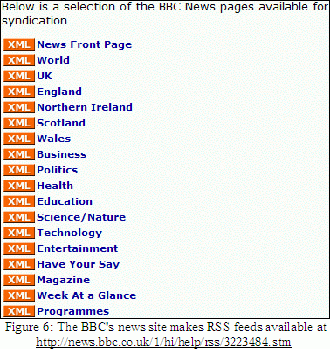
This is the icon
that she found on many blogs – online diaries – that she
enjoyed reading. One of these was the blog
of Margot Wallström, the Vice-President of the European
Commission. Her site had developed a loyal readership and seemed a
public relations triumph. Mrs Shrub wondered if she could create a
similar blog to reach her voters in London.
M. Braille filters
out his spam mail
 Sadly,
having an email address means receiving junk emails. However, when
Thunderbird collects your email messages you will notice that many of
the spammers' messages have a
Sadly,
having an email address means receiving junk emails. However, when
Thunderbird collects your email messages you will notice that many of
the spammers' messages have a
 icon. This is Thunderbird's Junk
Mail Control... at work.
icon. This is Thunderbird's Junk
Mail Control... at work.
However, not all
the junk messages will have the icon. Select each of these and click
the Junk
button at the top of the window. Conversely, some messages will have
been identified wrongly as junk mail. Select each of these and click
the Not
Junk button.
Although M. Braille received many messages every
day from family, friends and co-workers, he received even more junk
messages from spammers. After a few days of manually overriding the
junk status that Thunderbird had assigned to each of his messages he
noticed that the program's accuracy was improving.
This is because the junk mail feature changes its
rules to match more closely the judgement of the user. It also
refrains from labelling as junk mail any messages that come from
email addresses that are already contained in your address book.
Thunderbird has a subtle feature for blocking the
efforts of spammers – it does not automatically show the
pictures in an email if the picture was not included with the email.
This is because some spammers simply include a reference to a picture
in the mass emails that they send out. Some email software
automatically follows those references, connecting to the internet to
get a copy of the pictures and then displaying it. However, as soon
as the software connects to the internet it confirms to the spammer
that the email address is a legitimate one. The spammer targets
confirmed email addresses even more strongly.
By not automatically following
such references Thunderbird prevents the confirmation that spammers
thrive on. The Show
Images button allows manual
overriding in each message (see Figure 7).

Soon M. Braille
trusted the software enough – it did not label everything
correctly as junk mail, but it stopped incorrectly labelling any of
his legitimate messages as junk mail. From the Tools
menu he selected Junk
Mail Controls... and switched on
automatic message handling. This meant that Thunderbird automatically
moved junk mail messages to a separate folder, clearing his Inbox.
Inspired by this
automation M. Braille began reading about the Message
Filters...
command in the Tools
menu. This allows setting rules for handling new messages.
He added a rule so that Thunderbird automatically
moved every message from his colleagues at the charity to a folder he
called “Charity”. He created another folder called
“Lit-Ideas”. This was for messages that he received from
the Lit-Ideas mailing list,
an entertaining discussion list for university professors in the
humanities to discuss the impact of technology. Every message that
came from the list included “[lit-ideas]” in the subject.
M. Braille created a filter that automatically identified these
messages by their subject and copied them to the “Lit-ideas”
folder.
Ms Yates uses
extensions
 Ms
Yates had used several extensions for Firefox. She was delighted that
extensions were also available for Thunderbird from the Tools
menu.
Ms
Yates had used several extensions for Firefox. She was delighted that
extensions were also available for Thunderbird from the Tools
menu.
The
first extension that she installed was a dictionary
– this allowed her to look up the definitions of technical
words in her messages.
Another
extension allowed her to control her iTunes music player and most
other music players, including the Free Software Zinf.
This was important because she spent a lot of time every day reading
and writing her emails and she liked to do so with music playing in
the background. The extension's controls were available in every
Thunderbird window, meaning that she could fast-forward, rewind,
pause, play and change the volume without switching away from the
message she was reading. Another version of the extension gave her
the same controls on Firefox as well.
New
extensions are always being added and Ms Yates wanted to keep track
of all them. She found the Mozilla Foundation's RSS feed about new
extensions.
Mr Big uses
Mozilla suite
 One
of the key strengths of Microsoft Outlook is its calendar. This
feature is not included in the default installation of Thunderbird.
Several Free Software options are available.
One
of the key strengths of Microsoft Outlook is its calendar. This
feature is not included in the default installation of Thunderbird.
Several Free Software options are available.
One is to use
Thunderbird's extensions. For example, the Mozilla Calendar
extension
adds a Calendar
command to the Tools
menu. The calendar icon can also be added to the toolbar (see Figure 8).
The PalmSync extension
further strengthens Thunderbird's address book by allowing its
synchronisation with Palm Powered handheld computers.

However, other
Free Software tools are available that were designed with calendar
integration as a key feature rather than an afterthought. For
example, the Open Source Application Foundation is creating Chandler
(www.osafoundation.org),
with an impressive vision for personal information management.
However, it is still under development and a stable version is not
yet available.
On the other hand
Ximian Evolution is mature software that is similar to Outlook in
functionality and user interface but superior in security
(www.ximian.com).
It also integrates into the Microsoft Exchange email server, allowing
group calendar functionality. However, it is only available for
computers running GNU/Linux, not Windows.
In the end Mr Big
chose the Mozilla Suite (www.mozilla.org/products/mozilla1.x/),
after which the Mozilla foundation was originally named. Its
integration is even greater than Outlook's, combining web browsing,
email handling, RSS reading, calendar functionality and web page
creation.
And because it is based on the Mozilla
Foundation's technology, it can use the same extensions that are
available for Firefox and Thunderbird.
Further
resources
Creating a basic
website
In 2004, King Sihanouk of
Cambodia abdicated his throne.
The world and his parliamentarians, found out about this through his
personal website (www.norodomsihanouk.info).
During 2003, Salam Pax (http://dear_raed.blogspot.com/)
described to readers around the world his daily experiences during
the fighting between the US and Saddam's army. And in 2005,
BoingBoing (www.boingboing.net)
continues to fascinate as “a directory of wonderful things”.
A website is a great way to share information with
others around the world.
To create a website, you need three things. First,
you need content in the form of webpages. Writing a webpage is
simpler than writing a word processing document, so if you are
comfortable with OpenOffice.org Writer then you will find creating a
webpage is easy.
Second, you need a computer to store the webpages
for your readers. This is called a webserver. Running your own
webserver is expensive and can be a full-time job. But renting a
webserver is easy and affordable and some companies even offer the
service free of charge. The companies that rent out parts of their
webserver to host your website are called webhosts.
Third, you need a web address
so that other people using the web can find the webserver containing
your webpages. Examples of web addresses include
www.freedomsoftware.info
for this book. The address also allows others to email you. For
example, you can email me at mo@freedomsoftware.info.
The costs of these steps are constantly dropping,
the ease of starting is constantly improving and this chapter will
demystify the basics.
What is most important to learn from this chapter
is that there are many possibilities for your own website. Each of
the characters uses their site for different reasons and you will
have reasons of your own.
It is a common reaction to feel shy about setting
up your own website for the first time. However, we all have
something to tell others about, whether it is our day's events for
family and friends to read about, or our professional expertise for
colleagues to learn from.
You may feel scared about the risks and workload
of your website and you are right to think ahead. There are four
points to mention. First, avoid putting information on the internet
that you do not want everyone
to learn about. It is possible to secure your website so that only
certain users can read it, but this takes some knowledge and is never
without risks. So stick to sanitised information, at least at the
start. In other words, do not broadcast your love life, or your
complaints about your boss. On the other hand these topics make for
some of the most charming and compelling reading material on the web
and in time you will gain the confidence to discuss them in a way
that minimises the risks to you.
Second, running a
webserver is often a full-time job because of the constant attacks
from malicious computer users. However, by renting a webserver you
avoid all these headaches as there are professionals taking the load
for you. On a good webhost's website you will see a guarantee of at
least “99.9% uptime”, which means that they will ensure
that their webserver makes your website available at least 99.9% of
the year. In a single year, your website will be working for almost
every single hour of every single day, faltering for no more than 9
hours in total.
Third,
writing for the web is different from traditional writing. Dr. Jakob
Nielson has excellent introductory articles
about this, while Dan Briklin's site provides a wonderful guide
(www.gooddocuments.com)
from a pioneer.
Finally, the workload of creating and maintaining
a site can build up, especially as you come to enjoy writing and your
website's visitors enjoy reading. On the other hand, that may not be
a bad thing. But start with a simple site and slowly add content to
it.
What most often astonishes new
authors is how quickly the content on their website grows. My
personal website (www.mo.md)
began as a single article that I wrote about handheld computers. I
began occasionally adding articles, until a medical company noticed
it and commissioned a ten-part series from me. Soon I had readers
from around the world and in time I decided that I had enough
material for a book. “Handheld Computers for Doctors” was
the result (www.handheldsfordoctors.com).
Examples
Mr Salah Al-Din and his
students use OpenOffice.org for simple websites
(page 31)
Ms Yates uses NVU to
create her company's website (page 33)
M. Braille uses PayPal
and Amazon to collect donations through his website
(page 36)
Mrs Shrub uses
CivicSpace to blog (page 38)
Dr Digitalis uses
WordPress to create a blog about acupuncture
(page 40)
Mr Big's employees use
WordPress blogs to keep colleagues informed
(page 41)
Mr Salah Al-Din
and his students use OpenOffice.org for simple websites
 To
create your first webpage you only need OpenOffice.org. From the File
menu selected New
then HTML
Document. HTML is an abbreviation of
HyperText Markup Language, which is the name the Sir Tim Berners-Lee
had given to the language he invented back in 1989 and all webpages
are written in HTML.
To
create your first webpage you only need OpenOffice.org. From the File
menu selected New
then HTML
Document. HTML is an abbreviation of
HyperText Markup Language, which is the name the Sir Tim Berners-Lee
had given to the language he invented back in 1989 and all webpages
are written in HTML.
Mr Salah Al-Din's school already had a website,
but it consisted of just a few pages. Mr Salah Al-Din wanted to give
each of his students some space on the school website so that they
could express themselves and improve their writing skills.
Because the school already had a webserver and a
web address, all Mr Salah Al-Din had to worry about was the tools for
creating the extra webpages.
OpenOffice.org HTML editor is easy to use because
its icons are identical to those of OpenOffice.org Writer. You can
make text bold,
italicized or
underlined by clicking on
the
 ,
,
 and
and
 icons respectively.
icons respectively.
Inserting images in a document is also similar to
OpenOffice.org Writer: select Graphics...
from the Insert
menu. However, there is one important difference. It is better for
the image file to already be in the same folder as the HTML file.
You can also create hyperlinks to other webpages.
From the Insert
menu select Hyperlink.
If the hyperlink is to another webpage in the same website, click on
the Document
icon on the left hand side, then the
 icon in the top right corner (see Figure 9).
icon in the top right corner (see Figure 9).
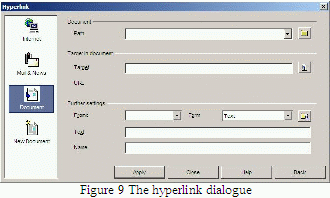
For example, one student created several webpages in her folder, each
containing a single essay. The student then created a single page
with the titles of all the essays. For each title, she selected its
text then inserted a hyperlink to the webpage with the full essay.
And on every essay's webpage she wrote “Home” at the top
of the page and inserted a hyperlink to the page listing all the
essays. In this way her parents could start with that page, click on
the title of every essay that they wanted to read and click on “Home”
to get back to the list when they had finished reading an essay.
To link to any other webpage on the internet,
click on the Internet
icon on the left hand side. Then type in the address of the webpage
into the Target
field and click the Apply
button.
For example, another student liked to quote a lot of references in
his essays. Many of those references were available on the internet,
so he selected the title of each reference and inserted a hyperlink
to the website with the full text. Other references were to books
that were not available on the web, so the student created links to
the Amazon.com pages that contained more information about the books.
By following a link the reader would find reviews of the book, find
out information about its publisher and buy it.
However, OpenOffice.org is only capable of basic
HTML. For more sophisticated layout or advanced HTML features the
students needed more professional HTML editing software. The students
began reading books about webpage design
and searching the internet for more information.
That is how they found out about NVU.
Ms Yates uses NVU
to create her company's website
 You
can get a web address in ten minutes for less than $10 per year. Type
in the name of your organisation as one word at www.godaddy.com
then click the Search
button (see Figure 10).
You
can get a web address in ten minutes for less than $10 per year. Type
in the name of your organisation as one word at www.godaddy.com
then click the Search
button (see Figure 10).
There are several alternative
endings for your web address. For example, .com
is for companies with global customers, .co.uk
is for UK companies and .org
is for non-profit organisations.
Ms Yates bought a .com address.
Within 48 hours her address was working. She ordered some new
business cards that included her website and email addresses. For a
webhost, she chose SiteGround (www.siteground.com).
A typical SiteGround account costs $60 for each
year's service. This includes 1 GB of space, which is enough for
detailed photographs. The performance of the site is good enough for
starting and would cope with Ms Yates's expanding needs for at least
the first few years.
Finally, for writing the
webpages, she chose NVU (www.nvu.com).
It allows more sophisticated page design than OpenOffice.org as it
can handle tables.
NVU also copes better than OpenOffice.org does
with multiple interlinked webpages. As your site expands, you will
rearrange and reorganise the webpages. NVU automatically updates the
links between the pages.
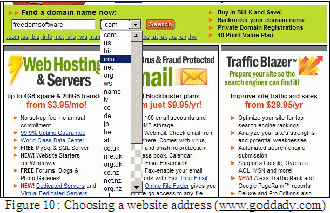
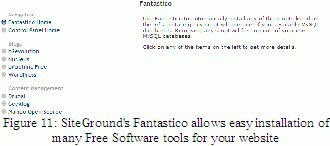
Finally, NVU can copy the
webpages from your computer to your webhost's server. You will need
some details from your webhost and SiteGround includes these in the
welcome email you receive on setting up your account. Enter these
details into NVU using the Edit
sites button on the left hand side
(see Figure 12).
The software is similar enough
to OpenOffice.org to use comfortably for writing. However, designing
the correct layout takes some more effort. The easiest way to get
started is to use Firefox and find some websites that you like. From
the Firefox File
menu select Save
Page As... to save a copy of the
webpage on your computer. Then Open
the copy in NVU and customise it to suit your needs.
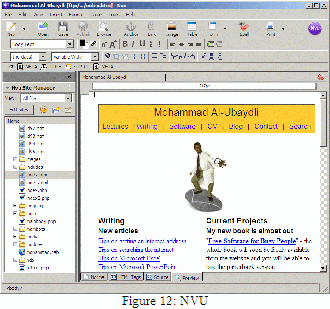
M. Braille uses
PayPal and Amazon to collect donations through his website
 Two
companies make it easy to receive credit card payments through your
website: Amazon (www.amazon.com)
and PayPal (www.paypal.com).
Around the world millions of people trust these companies to handle
their online transactions.
Two
companies make it easy to receive credit card payments through your
website: Amazon (www.amazon.com)
and PayPal (www.paypal.com).
Around the world millions of people trust these companies to handle
their online transactions.
M.
Braille wanted to use his website to raise money for his charity. He
bought an address ending in .org and created three documents.
For the first he used OpenOffice.org Writer to create the complete
brochure about the charity with photographs of the children, the
school and its staff. He then exported the document in PDF format.
For the second document he used NVU to create the
main webpage of his website. It also contained a hyperlink to the PDF
document that he had created and another to the download site for
Adobe Reader.
The former link would allow visitors to his site to get the brochure
about the charity's work and the latter ensured that any visitors who
did not have Adobe Reader software could download a free copy before
dowloading the brochure.
To handle the donation through
PayPal he used his charity's bank account in France. He registered
with PayPal's French site (www.paypal.com/fr/)
and waited for a few days while the company verified his bank account
details. Logging in to PayPal's site he was able to access its Outils
marchand (merchant tools) section to
create payment buttons (see Figure 13). For each button he specified
the currency and amount of payment.

Whenever a user clicks one of these buttons PayPal
would guide them through the payment process, transferring the
appropriate amount in the appropriate currency from the donor's bank
account to that of M. Braille's charity.
M. Braille used PayPal to create buttons for the
Euro, Pound Sterling and US Dollar currencies. For each currency he
created three levels of payment. At the end, PayPal provided him with
the HTML code for nine payment buttons. He copied these codes into
NVU under the heading “Donate using PayPal”.
The final page that he created, again using NVU,
was a “Thank you” page. This was the page that PayPal
would show to donors after they had completed their donation and
allowed M. Braille to thank the donor in French and in English.
For Amazon donations he used
Amazon's Honor
System feature. This required him to
have an American bank account to receive deposits so he provided the
details of a sister charity in the USA. At the end of this Amazon
presented him with HTML code, like PayPal's, that he added to his
webpage in NVU.
Underneath the Amazon donation button he included
the 501(c)(3) information about the American charity. This would
allow Americans to count their donation as tax-deductible.
The beauty of this system was its low cost.
Annually, the charity had to pay around $100 for the domain name and
hosting. Furthermore, PayPal and Amazon do not charge any setup fees,
simply taking around 5% of each donation. Just $105 in donations
would have made the site self-financing. But as it happened, the site
became quite profitable, attracting interest and donors from around
the world, including people that the charity's French postal mailings
had not previously reached.
Mrs Shrub uses
CivicSpace to blog
 The
2004 US presidential elections demonstrated the use of weblogs
by the political candidates. Weblogs – or blogs, as they're
commonly known – are websites in which the author can keep a
log of events and their thoughts about these events.
The
2004 US presidential elections demonstrated the use of weblogs
by the political candidates. Weblogs – or blogs, as they're
commonly known – are websites in which the author can keep a
log of events and their thoughts about these events.
To a reader a blog is a webpage with several
entries. Each has a date, a title and some text. The newest entries
are at the top and the oldest at the bottom.
Readers of blogs like them because they can easily
see the latest entries – in the US elections candidates placed
their opinions about the most recent issues and provided links to
more detailed information. Voters were able to follow these to make
informed decisions.
Authors of blogs like them because they make
writing easy – all you would need is a web browser with access
to the internet. You can access your own blog, log in and fill out a
new entry. For politicians travelling around the USA this was a
godsend.
Furthermore, the structure of a blog means that
the author does not have to worry about the layout, only the writing.
These efforts contributed to Howard Dean's ability
to raise several million dollars. Ultimately, Dean failed to secure
the nomination of his party, losing to John Kerry.
However, the software that his
team had developed continued to be developed even after his campaign
ended. Now called CivicSpace (www.civicspacelabs.org),
it is available as Free Software and developers around the world have
joined the effort to improve its features.
Mrs Shrub was halfway through her term which meant
that she would soon begin campaigning again. For now, she had enough
time to learn to write her blog and for her team to begin forging
relationships with the authors of other blogs.
Dr Digitalis uses
WordPress to create a blog about acupuncture
 A
key advantage of choosing SiteGround for web hosting is its
Fantastico
control panel (see Figure 11). It allows you to quickly and easily
install a whole range of Free Software. This includes the WordPress
blogging software (www.wordpress.org).
A
key advantage of choosing SiteGround for web hosting is its
Fantastico
control panel (see Figure 11). It allows you to quickly and easily
install a whole range of Free Software. This includes the WordPress
blogging software (www.wordpress.org).
Dr
Digitalis wanted to write a blog to keep track of developments in
acupuncture and store links to the articles that she found useful.
From godaddy.com she bought an address ending in .info. In her
SiteGround account she installed WordPress.
Every day, during her reading of the latest
literature, she would pick a few articles about which she would
write. For each she included a link to the article, a few choice
quotes from its text and her own comment on the article.
This was useful for her memory. First, because she
had spent this effort on each article she found it easier to remember
the contents of the article on future occasions. Furthermore,
WordPress indexes all the entries and provides a search box. She
could enter into the search box the keywords of the article that she
was interested in finding and WordPress would show a list of the blog
entries that included these keywords. The more detail she included in
each of her entries the easier it was to find the article again.
In time, however, other doctors found the blog
useful. Many of them were GPs and found the background explanations
that she gave to be useful and entertaining. They, in turn,
recommended it to other colleagues. For this kind of recommendation
it was important that the web address that she had chosen was short
and memorable.
What Dr Digitalis had not expected was the number
of new referrals coming her way because of the blog. By providing an
educational service she was also demonstrating to other GPs her
knowledge and her ability to explain things clearly to patients that
the GPs would send. All this without advertising.
Mr Big's employees
use WordPress blogs to keep colleagues informed
 More
and more businesses are finding the advantages of blogs written by
employees for internal communication. WordPress allows the creation
of different user accounts and different entry categories.
More
and more businesses are finding the advantages of blogs written by
employees for internal communication. WordPress allows the creation
of different user accounts and different entry categories.
The manager of the San Francisco hotel showed Mr
Big the employee blogs. Using an internal server, available only to
employees within the hotel's network, the team had installed
WordPress.
This meant that each of the senior employees could
write entries about their own department's work. For each entry
WordPress would display the name of the author as well as its date.
The author would also tick the categories to which the entry was most
appropriate, for example “maintenance”, “room
service”, “customer feedback” and so on.
This was a great way to communicate amongst the
different employees who worked different shifts in different parts of
the hotel. If an employee wanted to check on the progress of a
particular item of maintenance they would search the blog.
Some employees found this so useful that they took
advantage of the RSS feature on WordPress. This would allow them to
subscribe to the blog in Thunderbird, to receive all the entries. At
the start of their shift they would spend around 15 minutes reading
all that had gone on in the previous shift.
Mr Big ordered that WordPress be installed on all
the internal servers of all the hotels. The regional managers found
they could subscribe to the RSS feeds of all the hotels that they
were responsible for. The other employees around the world took some
training before they understood the benefits – not all of them
were like the technophiles of San Francisco.
But soon they too found the act of documentation
and the ease of searching others' documentation to be useful. In fact
the pendulum began swinging too much in that direction with some
managers asking that every employee use the blog.
This was possible in the hotels that provided
computers and internet connections in every room: junior employees
that worked on individual floors could login to WordPress using the
computers in customers' rooms and document their progress during the
day.
However, the problem with this was the information
overload. Regional managers subscribing to the RSS feeds of a hotel's
blog were flooded with entries announcing that the cleaning of a
particular floor's rooms had been completed.
The company's policy became that the main blog was
for senior employees. Each hotel manager could then choose to have
another copy of WordPress for junior employees. This would only be of
interest to that hotel's employees but allowed those employees the
freedom to use it in the way that suited their work habits.
At any rate the experiment was now enough of a
success that Mr Big was looking for other solutions that Free
Software could bring to his web servers. Perhaps San Francisco would
show the way again.
Further
resources
Creating a large
website
Amazon is more than a bookshop – it is your
bookshop. After a few visits to and purchases from the site, it
begins to include recommendations that are eerily attuned to your
tastes. But when I
visit the site I see different recommendations, ones that are
tailored to my tastes rather than yours. And when your friend visits
the site they will see recommendations that are also unique to them.
This is all possible
because Amazon's website is built on a database. A database is a
place to store data – think of it as an electronic filing
cabinet. Amazon collects all sorts of data about you, including your
billing address and orders of course, but also your rating of these
books and even book links you click on. It also compares data about
you with data about other customers and uses that to generate more
data.
All of Amazon's pages
are shown to you after consulting the database. If you are ordering a
book Amazon shows you previous delivery addresses that you used, in
case you want to use one of them again. If you are looking at a book
Amazon shows you ratings by other users who have read the book. Most
lucratively, Amazon constantly extrapolates from your previous
behaviour to recommend books to you that you would not have known
about or thought of reading.
You, I and others buy
these books because Amazon is not in the books business as much as in
the database business. And databases are the beauty of the web.
The websites that you
build with OpenOffice.org and NVU will for the most part not be
database-driven. It is possible and many web programmers do so, to
use NVU to develop database-driven sites. But for most people the
process is complicated and requires too much training.
However, WordPress is a
tool that allows the easy creation of database-driven sites. To add
entries to a blog you need a username and a password, which WordPress
keeps track of. WordPress can keep track of the login details of many
users and it stores the date and authorship data about each entry.
WordPress is not the
only Free Software that allows you to create database-driven sites –
there are other tools and many are far more powerful.
But of course with
power comes complexity. These tools require time and knowledge to set
up and administer but they make it easy to create and edit content.
So this chapter does not provide a tips section to explain how to do
everything – reading the documentation for every tool is
necessary for this.
This is why you might
find it useful to hire someone's services, at least for the setup
phase of your site. After that you will have the tools and ability to
focus on content. So the rest of the chapter is to give you ideas on
what you might do with the tools. Welcome to the database business.
Examples
Dr Digitalis
creates a discussion board (page 47)
Ms Yates uses the
Mambo content management system (page
50)
Mr Salah Al-Din's
students use a Wiki to collaborate in writing
(page 52)
Mrs Shrub uses
CivicSpace for her campaign (page 54)
M. Braille uses
Claroline to run courses (page 55)
Mr Big uses
dotProject for project management (page
57)
Dr Digitalis
creates a discussion board
 Bulletin
boards, or discussion boards, allow the posting and reading of
comments about different topics. Phpbb (www.phpbb.com)
is a popular Free Software version.
Bulletin
boards, or discussion boards, allow the posting and reading of
comments about different topics. Phpbb (www.phpbb.com)
is a popular Free Software version.
Dr
Digitalis found it under the Discussion
Boards heading of SiteGround's
Fantastico. It took three steps to install.
Since starting the blog Dr Digitalis was receiving
emails from clinicians around the UK and increasingly from abroad,
asking her questions about acupuncture
The questions were good for business because many
were followed by the referring of a patient. She also liked answering
these questions. However, some would always be beyond her expertise.
Others were simple and frequent, requiring her to type the same
answers several times in a week.
Discussion boards like phpbb make it easy for
people to ask questions and others to respond to the questions. It
also makes it easy to debate the answers.
Furthermore, by debating the answers through phpbb
the deliberations are available to future visitors to the site. A
visitor can search through past questions and answers.
Finally, phpbb allows each user to include
information about themselves. This pleases experts because each can
include information about their work.
Dr Digitalis recruited colleagues in China,
Toronto and California to share the load of answering the questions.
Their geographical spread ensured that there would be at least one
expert available to answer questions at any time.
Whoever sets up a phpbb site
becomes its Administrator.
This allows controlling the functioning of the site.
For example, at the start Dr Digitalis only
allowed registered users to see the questions and answers and only
allowed users to register after she had seen the details on their
application forms. She wanted to restrict questions to those from UK
doctors, so she would contact each of the applicants to ask for their
General Medical Council (GMC) number. This would provide a safe
environment for clinicians to discuss questions amongst themselves
and maintain patient confidentiality.
However, there were several problems with this
stringency. First, phpbb is a good system but it is designed for ease
of use, not security. Quite simply, Dr Digitalis understood that she
did not understand enough about security to provide the site's users
with guarantees of confidentiality.
Furthermore, many UK doctors bristled at the
registration requirement, assuming that Dr Digitalis wanted to send
them junk mail. And applicants without a UK GMC number would be
excluded. This meant that the international experts she had recruited
would be deprived of local clients and patient referrals. In fact the
restrictions on reading the discussion meant that Google and other
search engines could not index the site, depriving the experts of a
particularly significant source of clients: patients searching
Google.
Finally, it was simply too much work to look at
every single applicant's details.
Dr Digitalis switched to a more relaxed approach.
She allowed anyone to read any of the pages. She also allowed anyone
to register and to include as few details as they wanted to on
registration, but registration was still necessary to contribute
questions or answers. That way search engines and casual readers
could access the site while a little more commitment was necessary to
contribute.
Another administrative task is to organise a
site's discussion. Dr Digitalis created topics and subtopics to help
someone browsing through the site's past discussions. For example,
she created the “Consultations” topic for general
questions about patient problems that could benefit from acupuncture,
while the “UK”, “China” and “Canada”
topics dealt with country-specific questions.
The organisation of phpbb also allowed her to
devote some topic areas to issues that would concern her experts. She
chose to restrict the access to one area so that only the colleagues
that she had recruited could read its contents and add to them.
This allowed for reasonably confidential
discussions amongst her team. Most of these discussions centred about
the occasional registered user who was abusing the forum. She would
debate with her colleagues how to deal with the behaviour. When
appropriate, Dr Digitalis could bar that user from using the site and
remove any inappropriate contributions they had made.
In time she began to entrust her colleagues with
more responsibility on the site, upgrading their administration
privileges. This reduced the drain on her time from managing the
site. It also increased the commitment of her colleagues as their
profiles showed their new status.
Ms Yates uses the
Mambo content management system
 A
Content Management System (CMS) allows easy adding to and updating of
a website's content. Several are available from SiteGround's
Fantastico including Mambo (www.mambosource.com).
A
Content Management System (CMS) allows easy adding to and updating of
a website's content. Several are available from SiteGround's
Fantastico including Mambo (www.mambosource.com).
Authors like Mambo because its editing interface
is similar to a word processor's (see Figure 14). However, it still
runs inside a web browser like Firefox or Internet Explorer. This
means the authors can do their writing on any computer that is
connected to the internet. You can write while at work, at a friend's
computer, or in an internet café while on holiday.
Website administrators like
Mambo because it is so flexible. Someone with a little programming
knowledge can change every aspect of the website's appearance. There
are also hundreds of extensions available at www.mamboforge.net.
These add features to your website like discussion boards, group
calendars and shopping catalogues.
Ms Yates installed Mambo for
her company website. She searched Google for “mambo
templates” to find ready-made
designs for the site. She found several available free of charge but
paid $20 for a professional design from www.templatemuseum.com.
Customizing it was far easier than creating a template from scratch.
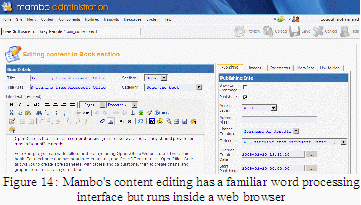
Of course the site lacked
content. Ms Yates already had several OpenOffice.org documents with
the text that she needed. She was able to Copy
and Paste
the text into her Mambo pages.
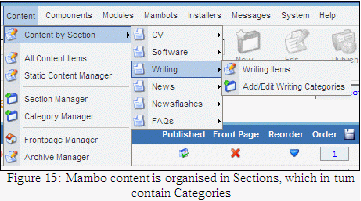
She installed mambo-shop
to manage her shop. This allowed her to handle different products,
currencies, shipping rates, taxes and payment methods. For the latter
she chose PayPal and WorldPay.
Mr Salah Al-Din's
students use a Wiki to collaborate in writing
 Wikis
are websites designed for easy collaboration on content. The
Wikipedia, at www.wikipedia.org,
is a great example of this tool in action. The site provides free
access to encyclopaedias in different languages. Each encyclopaedia
was written by hundreds of authors around the world. Each author
picks a topic about which they have an expertise then they write
about it.
Wikis
are websites designed for easy collaboration on content. The
Wikipedia, at www.wikipedia.org,
is a great example of this tool in action. The site provides free
access to encyclopaedias in different languages. Each encyclopaedia
was written by hundreds of authors around the world. Each author
picks a topic about which they have an expertise then they write
about it.
The twist is the peer review. Anyone can edit any
of the articles. This sounds like a recipe for chaos but the outcome,
in this case, is scholarly accuracy: if anyone writes an extreme
view, other authors with opposing extreme views alter the page. This
can lead to a back-and-forth of editing and counter-editing, but soon
the parties settle down on objective accuracy, reporting only the
facts that cannot be disputed and ensuring that all the facts are
included.
Mr Salah Al-Din used a wiki to help teach his
class about the Bahraini Constitution. In 2002 Bahrainis voted
overwhelmingly in favour of the new Constitution,
based on the one that had been suspended in 1975. Mr Salah Al-Din
wanted to help his students understand the document and its political
significance.
There are many different types
of Wiki software. Mr Salah Al-Din chose DokuWiki because its emphasis
was on easy documentation creation with a clean design
(http://wiki.splitbrain.org/wiki:dokuwiki).
The software has its own database as a text file, meaning that
installation is quick and easy. He uploaded the files to his server,
changed the access rules for some of the files as described in the
instructions and the system began working.
Security features were not so good, but this did
not matter in this case as the DokuWiki would only be reachable by
computers on the school's network, not by internet users outside the
network.
He divided his students into
teams. Each team would be in charge of one part of the constitution.
Writing this in a DokuWiki is easy. Each student would create a page
by typing its address in the web browser. For example, to create the
overview page they would type in doku.php?id=overview
while to create the page about Section 2 Article 3 of the
constitution they would type in doku.php?id=section2article3.
They made sure that the overview page listed all the pages in the
site and provided links to them so that a visitor could browse the
constitution.
The next stage was what excited Mr Salah Al-Din
the most. He asked each of the teams to compare the Bahraini
Constitution with that of another country. Then the teams would write
their thoughts in these comparisons. For example, the Bahraini
Constitution states that Islam is the religion of Bahrain, that all
citizens are entitled to education and healthcare and that the head
of state would be a member of the royal family chosen through
heredity. These features were in stark contrast to the US
Constitution.
After each team had written their comparison and
commentary he asked them to read and edit the efforts of every other
group. Of course this lead to lively debates amongst the students,
exactly as Mr Salah Al-Din wanted. The school was developing a
reputation for teaching civic leadership.
Mrs Shrub uses
CivicSpace for her campaign
 Mrs
Shrub's campaign team members were putting CivicSpace to great use.
The software's installation is easy and includes step-by-step
instructions to explain the various available options. The team chose
to use the site as a political
action platform which would allow
them to manage spreading information to the voters about the
campaign.
Mrs
Shrub's campaign team members were putting CivicSpace to great use.
The software's installation is easy and includes step-by-step
instructions to explain the various available options. The team chose
to use the site as a political
action platform which would allow
them to manage spreading information to the voters about the
campaign.
Two alternatives are also
available.The first, a
Slashdot-style community site,
mimics the features of www.slashdot.org.
That site, itself a Free Software project, is great for discussions
between participants but terrible for spreading information in the
top-down manner that campaigns depend on. The second, a
personal website or blog, was a
possibility for Mrs Shrub. However, it lacks the other features that
would have helped coordinate her campaign.
These include:
Forum topics to allow discussions amongst
voters, activists and campaign staff. In the early stages campaign
staff used these to coordinate their efforts with activists and
consult them on the messages with which to reach out to the voters.
In later stages the staff actively invited voters to pose their
questions and comment on the answers.
Polls to help quantify opinions. Of course
the data is not scientific or statistically representative, but
visitors to the site enjoyed taking part in topical surveys.
The story feature allows writing lengthy
articles.
The mass mailer streamlines the sending of
email messages to different groups.
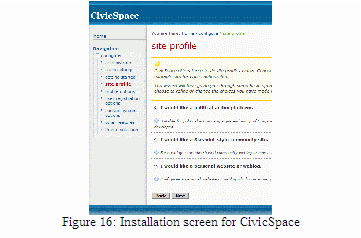
M. Braille uses
Claroline to run courses
 Apache
is the webserver software behind most websites and MySQL is open
source database software that powers an increasing number of them.
Both have proven their stability.
Apache
is the webserver software behind most websites and MySQL is open
source database software that powers an increasing number of them.
Both have proven their stability.
The latest computer that M. Braille received from
the GNU/Linux User Group ran Apache and MySQL. M. Braille did not
understand how to use these but he did not need to – once
installed, M. Braille could just add the computer to the network in
his school and the software would just work.
Because the network did not have access to the
outside internet M. Braille did not have to worry about security –
the only threat was attack from inside the network and that would
only come from the school children.
The computer also included
Claroline (www.claroline.net),
which is software for administering an educational institution .
When M. Braille logged in to his computer's
Claroline site he was presented with the view of a course teacher. He
could create as many courses as he wanted. For each course he could
write educational material and design exercises and tests. He could
also determine who had access to each course.
Claroline allows the monitoring of which student
had gone through which educational materials and exercises and their
scores on the tests. M. Braille could impose time limits for the
tests and weightings for the questions.
If M. Braille had wanted, he could have run a
university using this computer. In fact, France's Université
de Nantes, Britain's University of Glasgow, America's University of
Pittsburgh and over 350 other organisations from over 55 countries
around the world are using Claroline to deliver their education to
students.
But his ambitions were more modest. He wanted to
provide education to more of the parents of students in the village
by using his limited computer resources. He made five computers and
one assistant available to the parents of students so that they could
access his Claroline-powered website.
Thanks to the testing modules he could also
provide certificates for the parents as they learnt more and
completed harder tasks. The service was modest but it made a
difference to the parents and added to their pride. And he also knew
that educated parents can better support the education of their
children.
Of course the key was providing
useful courses and M. Braille greatly enjoyed writing these. But he
did not have to do all the writing – teaching materials are
free at Creative Commons (www.creativecommons.org).
The organisation allows
creators around the world to make their intellectual property
available to others according to each creator's individual
preferences. The education section provides lesson plans that are
freely available (www.creativecommons.org/education)
for reuse and customisation. In time he would be visiting Creative
Commons to make his own creations available to others
(www.creativecommons.org/license/).
But for now his students would be the beneficiaries of his teaching.
Mr Big uses
dotProject for project management
 Microsoft
Project is designed to help with managing projects. It can keep track
of the tasks for the project, the people carrying them out and the
progress of the project. For the latter, the software automatically
creates Gantt charts
to provide a visual representation.
Microsoft
Project is designed to help with managing projects. It can keep track
of the tasks for the project, the people carrying them out and the
progress of the project. For the latter, the software automatically
creates Gantt charts
to provide a visual representation.
The problem with all
versions before Microsoft Project 2003 is collaboration. Only one
person can enter information into the file at a time, which usually
means that one person becomes in charge of entering all the
information. That person must keep track of all the employees on the
project, as well as document their progress on all of the tasks.
Microsoft Project
2003 helps solve this problem by providing a version that works on a
server and a version that works on PCs. The server version keeps
track of the information that the individual employees submit using
the PC version on their own PCs. However, the server itself costs
$1,499 and then there is the cost of upgrading to the latest PC
version.
Mr Big is a fan of
Microsoft Project, regularly using the older PC version and insisting
that his immediate employees also use it, but this pricing was too
high.
So
dotProject (www.dotproject.net)
seemed like the perfect solution. It is a Free Software project
management server and its interface is accessible through any web
browser.
Once installed each
user can create as many projects as they need to manage. For each
project they can collaborate with as many users as necessary. Each
user in a project can enter information about the tasks they are
responsible for, including their costs, expected duration and
progress so far. The person managing the project no longer has to
enter this information but still gets to see it, including the
overview provided by Gantt charts that dotProject generates.
DotProject
allows storage of files. The team can collaborate on these files,
amending project proposals in OpenOffice.org Writer and presentations
in OpenOffice.org Impress. The Record
Changes
feature in OpenOffice.org keeps track of these amendments.
The creators of
dotProject cared about integration, making sure that it worked well
with other software. Most immediately Mr Big appreciated this because
he could import his old Microsoft Project files into dotProject. The
software also integrates into LDAP servers, meaning that Mr Big's
employees could use the same passwords to log onto dotProject as they
used to log on to their computers. Once logged in they could see the
contact details of all their colleagues because these had been
imported from the company's LDAP server. Similar tools are being
developed to integrate dotProject with the Mambo content management
system and with the SugarCRM sales force software.
The
creators also provided support contracts. The software is quite
stable and well tested but Mr Big insisted that dedicated support be
available to his IT department in case there were any problems. He
began with a US company (www.caseysoftware.com)
and added a contract with the Australian company that had started the
whole project (www.saki.com.au).
A third company, based in Brazil, is also available. The time zones
meant that the first two companies provided his staff with support
around the clock.
Further
resources
 Firefox
makes searching easy. Rather than visiting Google to begin a search,
type your search text into text area in the top right corner of
Firefox (see Figure 1) and press the return key. Firefox will show
you the list of results from Google. The tabs feature allows you to
study these results quickly.
Firefox
makes searching easy. Rather than visiting Google to begin a search,
type your search text into text area in the top right corner of
Firefox (see Figure 1) and press the return key. Firefox will show
you the list of results from Google. The tabs feature allows you to
study these results quickly.




 Mr
Big's Chief Technology Officer was relieved when the IT department
installed Firefox on all the PCs in all the hotels. Using Firefox
rather than Internet Explorer removed several important security
threats. It also saved the time of IT department staff who were
having to constantly keep up with Microsoft's security patches for
Internet Explorer and ensure that all of them were installed on all
PCs.
Mr
Big's Chief Technology Officer was relieved when the IT department
installed Firefox on all the PCs in all the hotels. Using Firefox
rather than Internet Explorer removed several important security
threats. It also saved the time of IT department staff who were
having to constantly keep up with Microsoft's security patches for
Internet Explorer and ensure that all of them were installed on all
PCs.


 Thunderbird
offers a useful way of getting the news. This is because many
websites offer RSS versions of their news stories and Thunderbird can
use RSS to collect those stories. RSS stands for the Really Simple
Syndication, but the name belies the power that it offers and the
professionalism of the organisations that offer it.
Thunderbird
offers a useful way of getting the news. This is because many
websites offer RSS versions of their news stories and Thunderbird can
use RSS to collect those stories. RSS stands for the Really Simple
Syndication, but the name belies the power that it offers and the
professionalism of the organisations that offer it.









